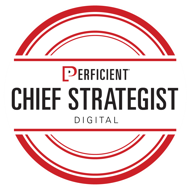Thrilling our clients with innovation and impact – it’s not just rhetoric. This belief is instrumental for our clients’ success. In 2018, we announced the first class of Chief Strategists, who provide vision and leadership to help our clients remain competitive. Get to know each of our strategists as they share their unique insights on their areas of expertise.
 Customer experiences that “wowed” us last year are table stakes today. Leading brands understand the importance of innovation for meeting and exceeding our expectations as consumers.
Customer experiences that “wowed” us last year are table stakes today. Leading brands understand the importance of innovation for meeting and exceeding our expectations as consumers.
For example, Walmart and Target continue innovating with more convenient shopping options for customers. Free two-day shipping? Buy online and pickup in store? Those are table stakes. Both have upped the ante again. Now, you can buy online and pick up your order without ever leaving your car.
This example points to the ever-increasing expectations our clients must satisfy to stay competitive. Our Strategy and Innovation team with Perficient Digital, led by Jim Hertzfeld, Digital Chief Strategist, helps clients conquer these challenges. His team is fiercely dedicated to moving the needle for our clients regarding customer experience, ideation, and investment strategies in their digital solutions.
We recently spoke to Jim and learned more about his aspirations as a Chief Strategist, his perspective on digital solutions, and his life beyond the world of strategy.
 What does this new role as a Chief Strategist mean to you?
What does this new role as a Chief Strategist mean to you?
Jim Hertzfeld: One of the things I admire about our Chief Strategist program is that it acknowledges our clients’ complex problems. Solving them requires different perspectives.
The value our Chief Strategist program brings [to clients] is having diversity of thought.
Perficient is able to provide an end-to-end approach for our clients, and then backs it with strategic vision to achieve end-to-end results. Our Chief Strategist program provides the diverse perspectives to build greater empathy with our clients, and, more importantly, with our clients’ customers.
As a Chief Strategist, I’m making sure that my team provides that customer perspective as part of a broad, diverse vision. It’s what creates better solutions and helps our clients be successful.
What does your role as a Chief Strategist entail?
JH: My domain of expertise is digital, which includes digital experience and overall customer experience. More specifically, this role focuses on using digital technology to build and improve relationships between our clients and their customers.
Our intention is to be with clients as much as possible. My team and I listen to our clients to understand their customers, competitors, and top challenges. Then, we tap into what’s possible and build big ideas around customer experience to drive growth, improve the brand, and strategically grow our clients’ businesses.
From a strategic perspective, we’re bringing discipline and tools to make good choices, so they can maximize the scarce dollars, resources, and time they have to stay relevant.
What do you hope to accomplish as a Chief Strategist?
JH: Among my top goals is making sure we have the right tools and information to formulate perspectives quickly. The machine we have to build has to operate swiftly and be informed by ongoing changes and new perspectives.
Any business in any industry realizes the limited longevity of a best practice. A best practice used to last 10 years. Today, it has a shelf life of maybe three years. It’s important to have the tools that will help us constantly keep [best practices] fresh and help us quickly react to our clients’ issues. They’re being disrupted, and we have to be there to help.
Another priority is supporting the collaborative work of the Chief Strategist program. A great example of this is our recent work with Christine Livingston, our AI Chief Strategist.
There’s a lot of information available about artificial intelligence (AI), especially around the topics of algorithms, big data, and machine learning. But there is little discussion around the intersection of AI and customer experience. Our clients understand the importance of having an AI strategy, but they aren’t sure where to begin. We’re moving quickly to find a way to do that, which is a great way to blend these different perspectives.
Strategically Speaking
Which digital trends are on the rise, or will be widely adopted in the near future?
JH: Omnichannel is a mature topic in retail, but it’s a concept that’s coming back, particularly in healthcare and financial services. These industries have made great multichannel investments but customers are not expecting the omnichannel conveniences they get elsewhere.
As far as customer experience, AI is hot – algorithmic AI for predictive analytics, personalization, and next best action. This is interesting now because data quality is better, and there’s greater access to data [in organizations], and the technology has matured enough where the promise of personalization is real. We’re seeing a lot of seamless, reactive, responsive personalization scenarios. I still believe convenience is more important than privacy for a lot of consumers, so we’re going to see a confluence of things happening in personalization this year.
Zero UI is also one to watch because there are interesting industry applications for the technology. One idea that I’ve heard from a couple of brands includes, “How do you take a conversation in the living room and start to drive advertising from smart TVs based on those conversations?” That’s easily possible. While there are a lot of privacy issues to overcome, there’s some utility to it in the consumer realm, but an even bigger upside in industry applications where privacy is not a blocker.
If you’re on the leadership team, why does strategy matter for your business?
JH: Strategy attempts to predict the future. It’s about making really good, disciplined choices when you have scarce resources, funding, and time. You’ve got to make smart decisions about where you want to take the future, not where the future is going to take you.
A great quote I like says, “The map is not the territory.” A map serves as your guide. Once you’re out in the forest, the field, or the city, that’s the territory. [The reality] is not always what the map tells you.
As a business, you must be equipped to be lean and agile, and then continue to make good decisions. Strategy is not just making a few good decisions up front. It’s about being prepared to make ongoing decisions and react to the changes you’re going to confront along the way.
Think Like a Chief Strategist
How does your team help clients on their digital transformation journey?
JH: Our team is dedicated to listening to clients and understanding their customers. What moves them? What do they want? Why do they behave the way they do? We seek to understand their customers and competitors to gain insights on where [our clients] stand in the market, in the eyes of their customers, and in society as a whole.
By deeply understanding our clients, their customers, and their challenges, we can prioritize these insights and make practical, pragmatic recommendations. Listening, observing, and having the patience to do that is important. Our clients value that as much as wanting to know, “What are the good ideas?”
There’s also urgency to strategy. Clients think, “We’ve got to do something tomorrow. So, what do we do first?” This is why empathy for your customers matters. You have to understand customers and what they’re expecting, what they’re feeling, and what their problems are so you can provide the next best thing for them.
Technology can present itself as a quick fix. However, our team ensures clients have empathy for their customers, and they’re advocating for their customers. Greater customer empathy means a better experience.
Better experiences translate to better brand scores, increased loyalty, more word of mouth, and more repeat business.
Tell us about a recent project you’ve tackled. How did we help the client achieve success?
JH: Our recent success with Lids is a great example. The team had big transformational ambitions and wanted to develop a new mobile shopping app. But they forgot about the “now” that needed to be addressed.
The more pressing issue at the time was around its fulfillment experience. Customers could shop online and pick up their order in the store, which is a service many other retailers offer.
However, if a customer ordered two items, then the products were sourced from different locations. When one of the two items arrived at the store, the customer received a notification and proceeded to the store to pick up the order. Many discovered [upon arriving at the store] that the other item wasn’t there. For Lids, this placed the burden on its customers to make two trips when she believed the entire order was ready.
It may sound trivial, but those little experiences add up. There’s no technology solution to fix those issues. Without understanding the deeper problem, businesses can’t focus their investments in technology. Those little things make a huge difference in the overall experience, and those experiences are what defines the brand today.
Make sure your business isn’t overlooking the “now,” or the current issues. It’s more expensive to gain a new customer than retain your existing customers. When you lose them, you have to start over and that becomes an expensive choice.
Beyond the World of Strategy
What are your interests or hobbies when you’re not wearing the Chief Strategist hat?
JH: I started out my career as an electrical engineer, so part of my brain or DNA is driven by creating things that didn’t exist before. This drives my interests, so I like to make things. I cook from scratch a lot, I design and build furniture, and have created some film, music, and artwork for fun. There is tremendous satisfaction in imagining something, figuring out how it would work, figuring out how it can be built – which are two very different types of problems – and then bringing it to life. Obviously, this is what drives our work, but it’s more than a vocation for me, and why I love this job.
“Making stuff” covers so many physical and intellectual bases for me: the physical craftsmanship required, the hard problem-solving and inventiveness needed, and the creativity and originality to really push an idea. For me, and a lot of makers out there, there is also a sort of higher purpose you look for when you craft something from nothing. The ultimate satisfaction is when you’re able to connect what you’re doing to the people for whom you love and care – your family, your friends, maybe your community. Whether it’s a coffee table for my son, a raised bed garden for my wife, or a scratch made barbecue for my best friends, you hope that you’re doing more than just sharing things, but building a connection to the people you care about.
Learn more about each of our Chief Strategists by following this series.

